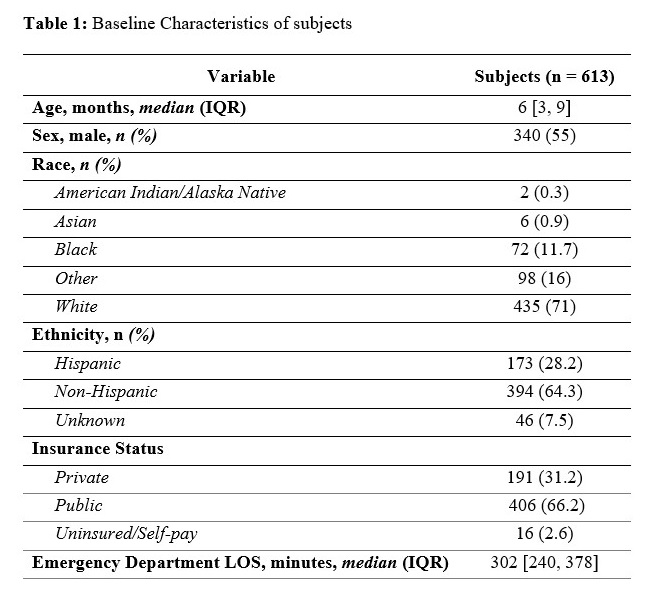Child Abuse & Neglect
Category: Abstract Submission
Child Abuse & Neglect II
237 - The Utility of Urinalysis in Identifying Occult Abdominal Trauma in the Evaluation for Non-Accidental Trauma
Monday, April 25, 2022
3:30 PM - 6:00 PM US MT
Poster Number: 237
Publication Number: 237.402
Publication Number: 237.402
Nidhi Singh, Baylor College of Medicine, HOUSTON, TX, United States; Katrin Lichtsinn, UPMC Childrens Hospital of Pittsburgh, PITTSBURGH, PA, United States; Molly Ray, University of Nevada, Las Vegas School of Medicine, Las Vegas, NV, United States; Karla A. Lawson, Dell Children's Medical Center of Central Texas, Austin, TX, United States; Matthew Wilkinson, UT Austin Dell Medical School, Austin, TX, United States

Nidhi Singh, MD
Assistant Professor
Baylor College of Medicine
HOUSTON, Texas, United States
Presenting Author(s)
Background: Abdominal trauma from abuse is the second leading cause of mortality and is challenging to identify in young patients due to their limited verbal skills, delayed symptoms, less muscular abdominal wall, and limited bruising. Bag urinalysis is used at many institutions as part of the evaluation for suspected child abuse without evidence for its utility.
Objective: The study aim was to determine the proportion of occult abdominal trauma cases identified using urinalysis that would not be identified by exam or other lab values. Additionally, we wanted to evaluate if there was a delay in a disposition while waiting for the bag urinalysis.
Design/Methods: Retrospective cohort study of children aged 0-12 months evaluated in the Emergency Department with skeletal survey and urinalysis for suspected child abuse between 01/1/2015 and 12/31/2017. Patients were excluded if the skeletal survey was obtained inpatient or for other purposes. For our primary endpoint, a urinalysis was considered positive if ≥10RBC/HPF. To determine our secondary endpoint of potential delays in disposition while waiting for urine results, we calculated the length of time from the last results from the workup (either skeletal survey or liver enzymes) to urinalysis result.
Results: 613 subjects were evaluated for suspected child abuse in the ED meeting our criteria. Of which, only 2 subjects had a positive urinalysis. One subject was deemed to have a urinary tract infection. The other was deemed to have blood from a catheterized urine specimen. Neither subject had further evaluation for possible occult abdominal trauma. For the secondary endpoint, there was a median of 65 minutes (range 0 - 730) additional length of stay awaiting the urinalysis result.Conclusion(s): There were no subjects with occult abdominal trauma identified by urinalysis alone during evaluation for suspected child abuse in the ED. Additionally, there was a delay in disposition while waiting for urine specimens.
Baseline Characteristics of subjects
Study flow chart.jpg)
Objective: The study aim was to determine the proportion of occult abdominal trauma cases identified using urinalysis that would not be identified by exam or other lab values. Additionally, we wanted to evaluate if there was a delay in a disposition while waiting for the bag urinalysis.
Design/Methods: Retrospective cohort study of children aged 0-12 months evaluated in the Emergency Department with skeletal survey and urinalysis for suspected child abuse between 01/1/2015 and 12/31/2017. Patients were excluded if the skeletal survey was obtained inpatient or for other purposes. For our primary endpoint, a urinalysis was considered positive if ≥10RBC/HPF. To determine our secondary endpoint of potential delays in disposition while waiting for urine results, we calculated the length of time from the last results from the workup (either skeletal survey or liver enzymes) to urinalysis result.
Results: 613 subjects were evaluated for suspected child abuse in the ED meeting our criteria. Of which, only 2 subjects had a positive urinalysis. One subject was deemed to have a urinary tract infection. The other was deemed to have blood from a catheterized urine specimen. Neither subject had further evaluation for possible occult abdominal trauma. For the secondary endpoint, there was a median of 65 minutes (range 0 - 730) additional length of stay awaiting the urinalysis result.Conclusion(s): There were no subjects with occult abdominal trauma identified by urinalysis alone during evaluation for suspected child abuse in the ED. Additionally, there was a delay in disposition while waiting for urine specimens.
Baseline Characteristics of subjects

Study flow chart
.jpg)
